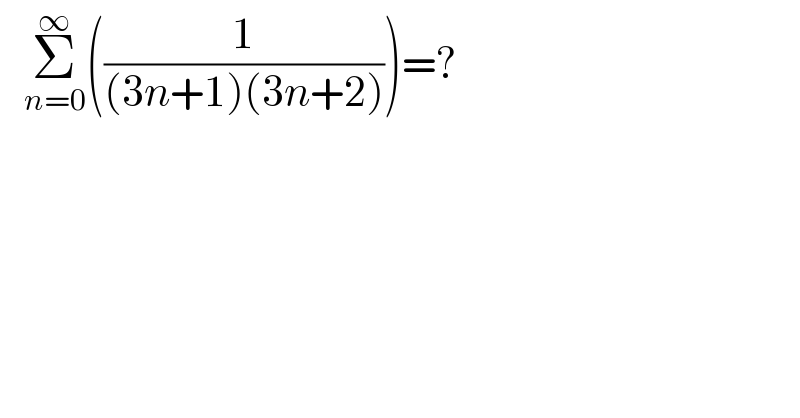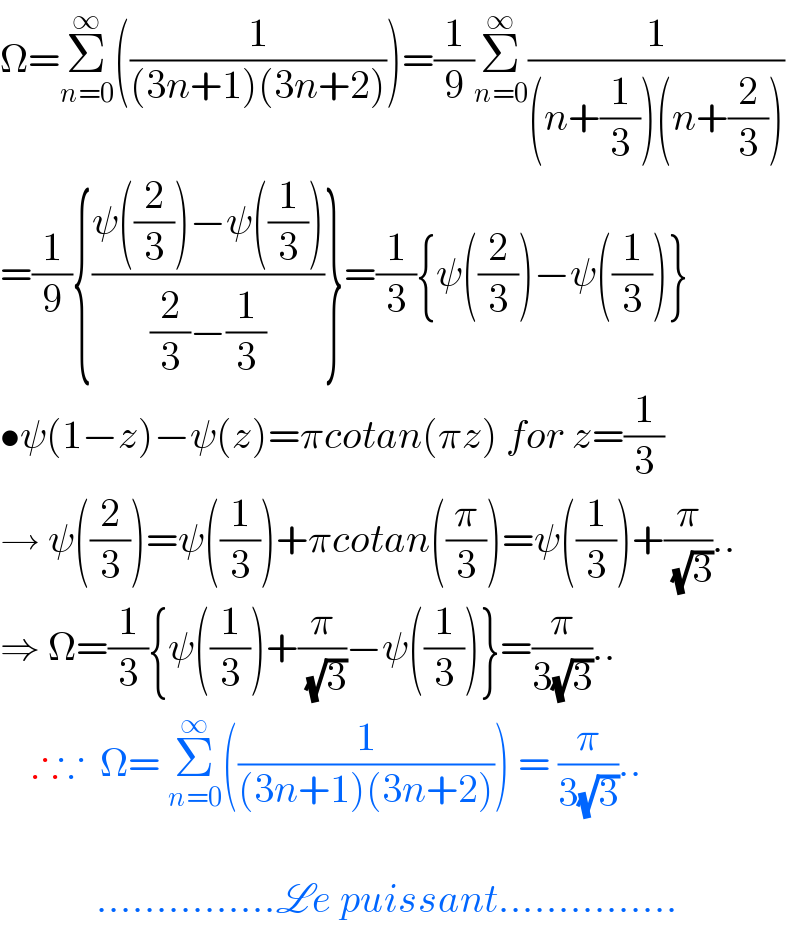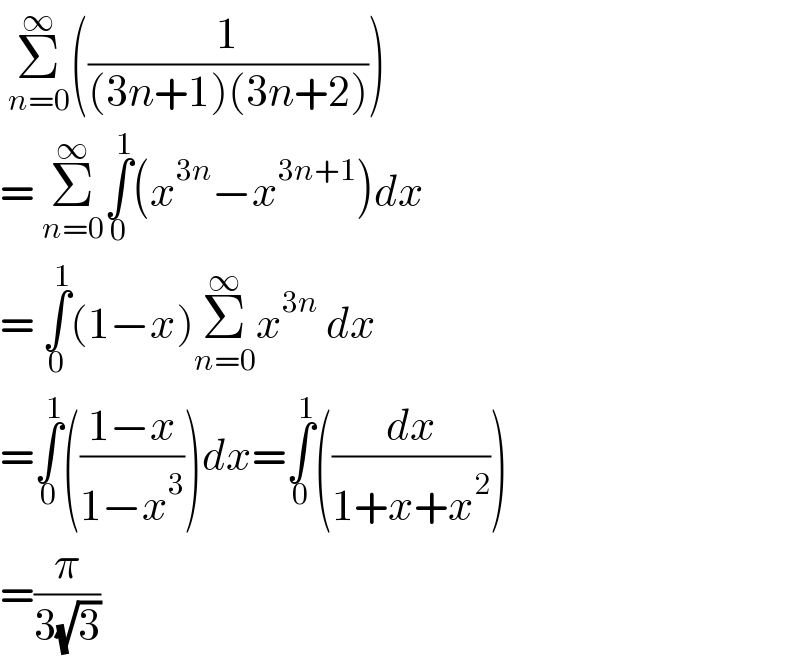Question Number 157120 by cortano last updated on 20/Oct/21

$$\:\:\:\underset{{n}=\mathrm{0}} {\overset{\infty} {\sum}}\left(\frac{\mathrm{1}}{\left(\mathrm{3}{n}+\mathrm{1}\right)\left(\mathrm{3}{n}+\mathrm{2}\right)}\right)=? \\ $$
Answered by puissant last updated on 20/Oct/21

$$\Omega=\underset{{n}=\mathrm{0}} {\overset{\infty} {\sum}}\left(\frac{\mathrm{1}}{\left(\mathrm{3}{n}+\mathrm{1}\right)\left(\mathrm{3}{n}+\mathrm{2}\right)}\right)=\frac{\mathrm{1}}{\mathrm{9}}\underset{{n}=\mathrm{0}} {\overset{\infty} {\sum}}\frac{\mathrm{1}}{\left({n}+\frac{\mathrm{1}}{\mathrm{3}}\right)\left({n}+\frac{\mathrm{2}}{\mathrm{3}}\right)} \\ $$$$=\frac{\mathrm{1}}{\mathrm{9}}\left\{\frac{\psi\left(\frac{\mathrm{2}}{\mathrm{3}}\right)−\psi\left(\frac{\mathrm{1}}{\mathrm{3}}\right)}{\frac{\mathrm{2}}{\mathrm{3}}−\frac{\mathrm{1}}{\mathrm{3}}}\right\}=\frac{\mathrm{1}}{\mathrm{3}}\left\{\psi\left(\frac{\mathrm{2}}{\mathrm{3}}\right)−\psi\left(\frac{\mathrm{1}}{\mathrm{3}}\right)\right\} \\ $$$$\bullet\psi\left(\mathrm{1}−{z}\right)−\psi\left({z}\right)=\pi{cotan}\left(\pi{z}\right)\:{for}\:{z}=\frac{\mathrm{1}}{\mathrm{3}} \\ $$$$\rightarrow\:\psi\left(\frac{\mathrm{2}}{\mathrm{3}}\right)=\psi\left(\frac{\mathrm{1}}{\mathrm{3}}\right)+\pi{cotan}\left(\frac{\pi}{\mathrm{3}}\right)=\psi\left(\frac{\mathrm{1}}{\mathrm{3}}\right)+\frac{\pi}{\:\sqrt{\mathrm{3}}}.. \\ $$$$\Rightarrow\:\Omega=\frac{\mathrm{1}}{\mathrm{3}}\left\{\psi\left(\frac{\mathrm{1}}{\mathrm{3}}\right)+\frac{\pi}{\:\sqrt{\mathrm{3}}}−\psi\left(\frac{\mathrm{1}}{\mathrm{3}}\right)\right\}=\frac{\pi}{\mathrm{3}\sqrt{\mathrm{3}}}.. \\ $$$$\:\:\:\:\therefore\because\:\:\Omega=\:\underset{{n}=\mathrm{0}} {\overset{\infty} {\sum}}\left(\frac{\mathrm{1}}{\left(\mathrm{3}{n}+\mathrm{1}\right)\left(\mathrm{3}{n}+\mathrm{2}\right)}\right)\:=\:\frac{\pi}{\mathrm{3}\sqrt{\mathrm{3}}}.. \\ $$$$ \\ $$$$\:\:\:\:\:\:\:\:\:\:\:\:……………\mathscr{L}{e}\:{puissant}…………… \\ $$
Commented by Tawa11 last updated on 20/Oct/21

$$\mathrm{great}\:\mathrm{sir} \\ $$
Answered by cortano last updated on 20/Oct/21

$$\:\underset{{n}=\mathrm{0}} {\overset{\infty} {\sum}}\left(\frac{\mathrm{1}}{\left(\mathrm{3}{n}+\mathrm{1}\right)\left(\mathrm{3}{n}+\mathrm{2}\right)}\right) \\ $$$$=\:\underset{{n}=\mathrm{0}} {\overset{\infty} {\sum}}\underset{\mathrm{0}} {\overset{\mathrm{1}} {\int}}\left({x}^{\mathrm{3}{n}} −{x}^{\mathrm{3}{n}+\mathrm{1}} \right){dx} \\ $$$$=\:\underset{\mathrm{0}} {\overset{\mathrm{1}} {\int}}\left(\mathrm{1}−{x}\right)\underset{{n}=\mathrm{0}} {\overset{\infty} {\sum}}{x}^{\mathrm{3}{n}} \:{dx} \\ $$$$=\underset{\mathrm{0}} {\overset{\mathrm{1}} {\int}}\left(\frac{\mathrm{1}−{x}}{\mathrm{1}−{x}^{\mathrm{3}} }\right){dx}=\underset{\mathrm{0}} {\overset{\mathrm{1}} {\int}}\left(\frac{{dx}}{\mathrm{1}+{x}+{x}^{\mathrm{2}} }\right) \\ $$$$=\frac{\pi}{\mathrm{3}\sqrt{\mathrm{3}}}\: \\ $$
